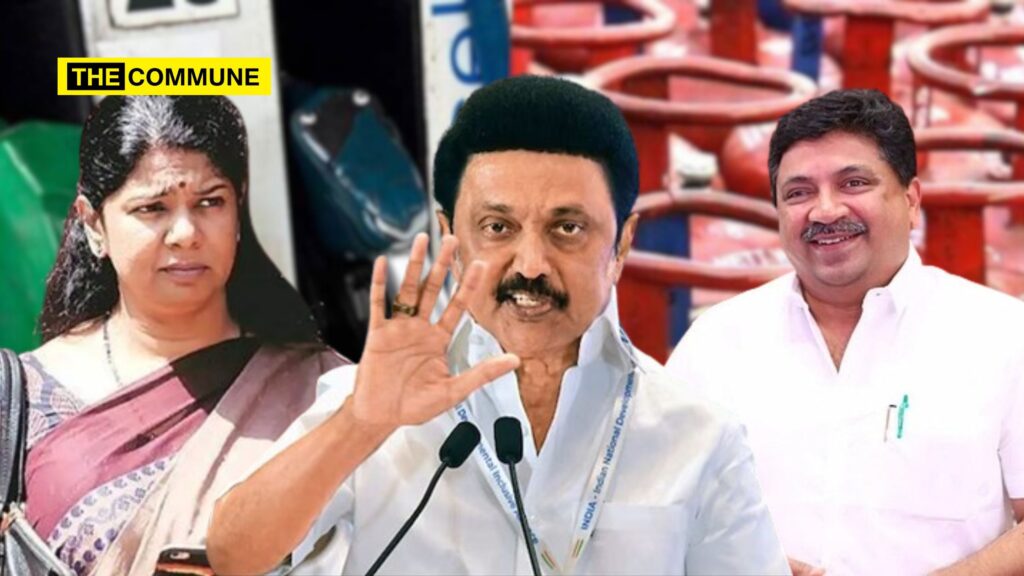The Dravida Munnetra Kazhagam (DMK) revealed its election manifesto on 20 March 2024, at Arivalayam, the party headquarters in Chennai. The presentation was led by MK Stalin, the party’s president and Chief Minister of Tamil Nadu, with the Election Manifesto Committee, headed by MP Kanimozhi, delivering the manifesto.
While many of the pledges in the manifesto were reiterated, some appeared contradictory, especially concerning financial commitments made without adequate consideration of their fiscal implications. This oversight could potentially strain the government’s revenue generation capacity and burden the treasury. Surprisingly, PTR Palanivel Thiagarajan, a Ph.D. and former Finance Minister of Tamil Nadu, was also part of the election manifesto committee.
Indeed, the agenda number 49 of the DMK’s electoral pledge is very concerning, as the proposed pricing for petrol, diesel, and LPG cylinders at ₹75, ₹65, and ₹500, respectively. Is this even possible? or the DMK’s resorting to its previous approach declaring electoral pledge to decrease petrol prices by ₹5 per liter and diesel prices by ₹4 per liter but reduced only ₹3 per liter. This aspect remains a matter for the architects of this agenda to contemplate.
The present DMK administration appears to be echoing the missteps of the former Congress government at the central level, which led to the escalation in petrol and diesel prices presently. This burden was subsequently shifted to the BJP upon its replacement of the previous regime. Eventually, the BJP, upon assuming power, rectified these errors, effectively restoring stability and profitability to the oil and petroleum sector.
Why This Is Not Possible
The pricing of gasoline in India is predominantly influenced by four key factors.
Firstly, international oil prices play a pivotal role, being tethered to the cost of crude oil, the primary ingredient in petrol. These prices are subject to global supply and demand dynamics, geopolitical tensions, the influence of the oil lobby, and market fluctuations.
Secondly, the exchange rate between the Indian Rupee and the US Dollar holds significance. A weaker Rupee escalates the expense of importing oil into India, consequently driving up gasoline prices.
Thirdly, the expenses incurred in refining crude oil into gasoline, along with the costs of raw materials, contribute to the final price.
Lastly, taxes imposed by the Indian government constitute a substantial portion of the retail price of gasoline, surpassing 50%. These taxes and duties significantly impact the overall pricing structure in the country.
Despite the price of crude oil in the market, the government is dependent on its taxes to meet its fiscal targets. The revenue generated from these taxes is ultimately allocated to fund various public services and infrastructure projects. Under the leadership of the current Modi government, infrastructure development has been prioritized, with significant investments being made to upgrade India’s infrastructure. One notable initiative is the Sagarmala project, which focuses on port-led development and is projected to cost over $120 billion USD. Another example is the Pradhan Mantri Gram Sadak Yojana, which aims to connect rural areas with all-weather roads and requires several billion dollars in funding. The taxes imposed on petrol are solely contributed to financing these projects.
If DMK is elected to power, from where will they generate revenue for such massive infrastructure commitments? Will they resort to strategies like the Congress’s Oil Bonds which involve sustaining losses for short-term electoral gains and ultimately burdening citizens. Former Prime Minister Manmohan Singh, in a 2008 address to the nation, rightly emphasized that issuing bonds and transferring deficits to oil companies is not a sustainable solution to the problem of high fuel prices. He warned against passing on the burden to future generations who would have to repay such debts.
In India, the pricing of LPG (liquefied petroleum gas) follows a method known as Import Parity Price (IPP), which undergoes monthly revisions. This approach relies on the LPG pricing established by Saudi Aramco, the world’s leading producer. The IPP encompasses various expenses like the free on board (FOB) price, ocean freight, customs duties, port charges, and insurance costs, initially calculated in US dollars and then converted into Indian rupees. Additionally, within the country, extra charges are incorporated into the international price, comprising inland freight expenses, profit margins for oil corporations, bottling expenditures, marketing outlays, dealer commissions, and the Goods and Services Tax (GST). The resultant price determines the retail selling price for non-subsidized cooking gas cylinders across different regions.
While many disadvantaged consumers in India benefit from government subsidies, receiving up to 12 subsidized cylinders under the Pradhan Mantri Ujjwala Yojana, the question arises regarding how the DMK intends to finance such schemes for the impoverished, considering their revenue commitments₹500 per LPG cylinder.
While the DMK’s pledges to fix prices for LPG at ₹500, petrol at ₹75, and diesel at ₹65 per unit may sound appealing, they seem unrealistic as they are proposed without considering their financial consequences. Such measures could hinder the government’s revenue generation capabilities and potentially strain the treasury. As Manmohan Singh aptly remarked, this approach may seem beneficial for citizens in the short term, but it could burden future generations of India with its repercussions.
Subscribe to our channels on Telegram, WhatsApp, and Instagram and get the best stories of the day delivered to you personally.

